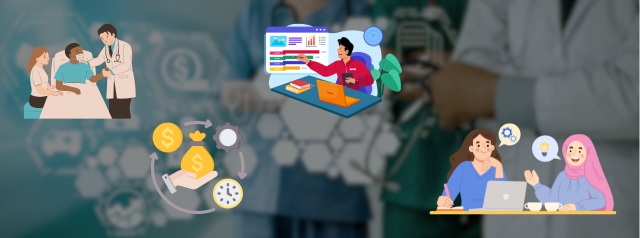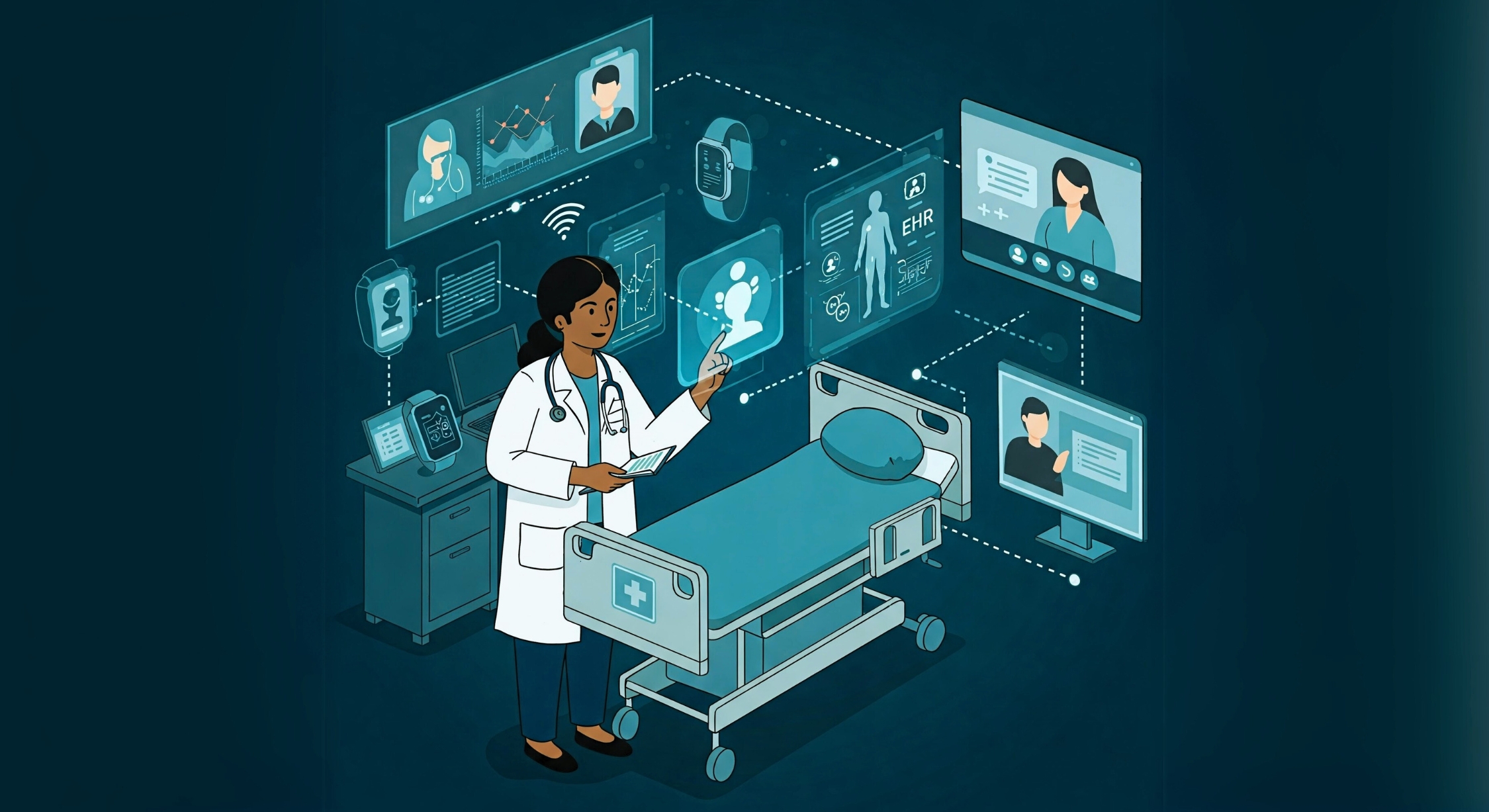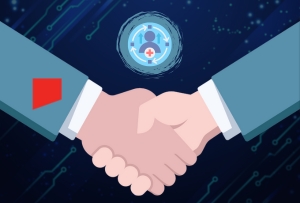Experion has worked at the heart of healthcare’s digital transformation, helping providers overcome the chaos of disconnected systems. Across continents and care settings, we’ve seen how fragmented technology can slow down care, bury critical data, and stretch clinical teams thin.
In hospitals, every patient journey generates data. Behind every consultation, test, and treatment, there’s a story unfolding; one made of data. A scan here, a lab result there, a billing update somewhere else. Each of these pieces holds a part of a patient’s journey. But more often than not, they’re scattered across different systems that don’t really talk to each other.
What happens next is a familiar scene: doctors waiting on results, nurses juggling duplicate records, and patients repeating the same details at every turn. It’s not just frustrating; it’s risky.
This is where healthcare system integration comes in. Not as another tool or software, but as a way to make sense of it all. To connect the dots between systems, so data can move freely and securely. When that happens, care becomes smarter, faster, and far more human.
Let’s take a closer look at how integration is quietly transforming the way care is delivered.
Understanding Healthcare System Integration

So, what exactly is healthcare system integration?
At its core, healthcare system integration is the process of connecting different healthcare software systems to enable the smooth and secure flow of information. It’s about ensuring that your EHR doesn’t exist in a vacuum, but can seamlessly exchange data with pharmacy systems, labs, billing platforms, imaging software, and even mobile apps that track patient vitals.
This isn’t just a backend upgrade, it’s a shift in how care is delivered.
When systems are isolated (a common issue called “data silos”), critical patient information can get buried, delayed, or lost in translation. A doctor might order duplicate tests simply because the lab results weren’t visible. Nurses may have to sift through multiple platforms to piece together a patient’s history.
But with integration in place, all stakeholders from front desk staff to specialists can access a unified view of patient data. The result? Smarter decisions, quicker interventions, and better care.
Why it matters:
- Reduces administrative duplication.
- Enhances collaboration across departments and institutions.
- Enables real-time insights that support evidence-based decisions.
- Minimizes medical errors due to incomplete or inaccurate data.
Imagine a cancer patient being referred from a general hospital to a specialist clinic. With integrated systems, their medical history, lab reports, radiology scans, and treatment notes follow them like a digital passport; no more paper files or redundant tests.
The Role of Technology in Connecting Disparate Healthcare Systems
Technology is the silent hero behind successful healthcare system integration. Here’s how it pulls the strings:
- APIs (Application Programming Interfaces):
These are like interpreters between systems. APIs allow different applications to “talk” in real time, fetching, sending, and updating data without manual interference. For example, an API can allow a doctor’s scheduling software to sync with a hospital’s central calendar. - Health Information Exchange (HIE):
HIEs are networks that facilitate the secure sharing of patient information across institutions, states, or even countries. This is particularly useful during emergencies, where immediate access to a patient’s history can be life-saving. - Cloud Computing:
With cloud-based platforms, healthcare organizations no longer need to rely on isolated local servers. Cloud infrastructure supports scalability, centralized data access, and remote collaboration, especially crucial in telemedicine and multi-location hospital networks. - Interoperability Standards (e.g., HL7, FHIR):
These are agreed-upon rules and data formats that ensure systems interpret shared data correctly. For example, HL7 (Health Level Seven) and FHIR (Fast Healthcare Interoperability Resources) help standardize how health data is structured and transmitted. - Middleware and Integration Engines:
Acting as digital translators, these tools map data formats, validate inputs, and route information between systems. Think of them as air traffic control, making sure every data packet reaches its destination accurately and on time. - Database Management Systems:
These systems consolidate scattered data sources into a structured format, making retrieval and reporting seamless. When data from wearable health devices, EHRs, and lab systems can be pulled into a single dashboard, care teams gain a clearer picture.
Key Challenges in Integrating Healthcare Systems
Integration may sound like a magic fix, but it comes with its fair share of hurdles. Let’s break down the major challenges:
- Data Standardization:
Different systems may use different terminologies (think: “BP” vs. “Blood Pressure”) or units (mg/dL vs. mmol/L). Harmonizing these variations is a daunting but essential task to ensure consistency and accuracy. - Legacy Systems:
Many hospitals still rely on outdated platforms developed decades ago. These systems often lack APIs or even basic connectivity features, making integration an uphill battle. - Security and Privacy:
Among other datasets, patient data is the most sensitive type of information. Ensuring secure data exchange that complies with laws like HIPAA or GDPR is critical. One breach can cause more than just reputational damage; it can cost lives. - Interoperability Issues:
Even with standards like HL7, not all systems implement them the same way. Vendors may tweak protocols, leading to compatibility issues. Getting different software platforms to cooperate is often like forcing a square peg into a round hole. - Cost and Complexity:
System integration requires skilled professionals, time, infrastructure upgrades, and ongoing maintenance. Smaller clinics may struggle to justify the investment without external support. - Organizational Resistance:
People don’t like change, especially in high-pressure environments like hospitals. Staff may be resistant to learning new systems or workflows, even if they promise long-term benefits. - Maintaining Data Integrity:
During data transfer, there’s always a risk of information being lost, duplicated, or altered. Ensuring accuracy throughout the exchange process is crucial for clinical decision-making.
Benefits of Healthcare System Integration

The true impact of healthcare system integration goes far beyond the backend. It transforms the very experience of care delivery. From patients and clinicians to administrators and insurers, everyone stands to gain.
- Improved patient care and experience
Integrated systems empower clinicians with a full view of a patient’s medical journey. When a physician can instantly access past diagnoses, allergies, imaging reports, and prescriptions, they are better equipped to make accurate and timely decisions. This not only improves the quality of care but also creates a smoother experience for the patient.
Patients no longer have to repeat the same information at every stop. Their history travels with them, whether they are at a general practitioner’s office, a specialist clinic, or an emergency room. It leads to faster access to test results, quicker diagnoses, and timely interventions when every moment matters.
Moreover, when healthcare providers work with shared data, communication between departments and teams becomes seamless. This reduces the likelihood of medical errors and enhances patient safety, especially during transitions of care.
- Enhanced operational efficiency and cost reduction
System integration streamlines workflows behind the scenes. Tasks that once took hours, like manually entering data or submitting claims, can be handled instantly by automated systems. This reduces the administrative burden and frees up healthcare staff to focus on what matters most: patient care.
Duplication of tests and procedures is a common cost trap in healthcare. When systems are connected, tests don’t need to be repeated because data is already accessible. This eliminates unnecessary expenses and improves the use of healthcare resources.
Revenue cycle management also benefits from integration. Claims are processed faster, denials are minimized, and reimbursements flow more smoothly. With fewer paper forms to process and less time spent correcting errors, cost savings are significant.
- Better data-driven decision-making
One of the most powerful outcomes of integration is the ability to turn data into insights. With access to aggregated, real-time patient data, healthcare providers and researchers can analyze trends across populations, track disease outbreaks, and evaluate the effectiveness of treatments.
Integrated systems support the creation of real-time dashboards and custom reports, enabling health administrators to monitor performance, optimize operations, and drive continuous quality improvement.
On the clinical side, these insights help develop more personalized treatment plans and support predictive analytics. It becomes easier to anticipate complications, adjust therapies, and manage chronic conditions more effectively.
- Strengthening collaboration between providers, insurers, and stakeholders
Integration encourages a more collaborative approach across the entire healthcare ecosystem. Different providers involved in a patient’s care can share notes, test results, and treatment plans without delay, creating a continuous and connected care journey.
Insurers also benefit from efficient data exchange, which speeds up claims processing and reduces errors. Patients, too, enjoy more transparent communication with their providers, improving engagement and satisfaction.
Whether it is a private hospital, a diagnostic lab, a public health registry, or a mobile telehealth platform, everyone is connected and informed. This is the foundation of a truly patient-centered model of care.
Key Components of Healthcare System Integration

Creating an integrated healthcare environment requires the right building blocks. These components serve as the backbone of a connected and intelligent health system.
Electronic Health Records (EHR) and Health Information Exchange (HIE)
EHRs are the digital equivalent of traditional patient charts, but with far greater functionality. They act as a central repository for a patient’s health data, accessible to authorized providers across various points of care.
Health Information Exchanges (HIEs) allow different healthcare organizations to securely exchange patient records. They ensure that a patient referred from one hospital to another can be treated with complete visibility into their history, allergies, medications, and previous procedures.
This is essential for enabling coordinated care, avoiding redundant testing, and improving the overall patient journey. HIEs also ensure that privacy is maintained during the data transfer process.
Interoperability standards (FHIR, HL7, DICOM)
Standards are the universal language of healthcare data exchange. Without them, integration would be chaotic and error-prone.
FHIR (Fast Healthcare Interoperability Resources) is a modern web-based standard designed for the digital age. It enables systems to exchange data in small, modular chunks that are easier to implement and understand.
HL7 (Health Level Seven) has long been a foundation for exchanging clinical and administrative data between software applications used by various healthcare providers.
DICOM (Digital Imaging and Communications in Medicine) is the go-to standard for handling medical images. It ensures that X-rays, MRIs, and other scans can be shared and viewed across different platforms without losing clarity or context.
Together, these standards allow diverse systems to communicate in a consistent and reliable manner.
Integration of IoT and wearable health technologies
Smart devices and wearable sensors are becoming increasingly common in everyday healthcare. They track everything from heart rate and sleep cycles to oxygen levels and blood sugar.
Integrating these devices into EHRs allows clinicians to monitor patients in real time. This is especially valuable for managing chronic conditions or for post-operative care where early intervention can prevent readmissions.
Patients also feel more engaged in their care when their devices contribute directly to clinical decision-making. It encourages healthier behavior and helps providers act on early warning signs.
The data generated can be used to shape preventive strategies, spot risk factors, and personalize care plans.
Telehealth and remote patient monitoring integration
Telehealth has become a staple of modern healthcare, especially in rural and underserved regions. But its true potential lies in integration.
When virtual consultation platforms are connected to EHRs, patient data from these sessions is instantly recorded and available for follow-up visits or referrals. Similarly, remote patient monitoring devices can transmit vital signs directly to healthcare teams, enabling timely interventions.
This enhances accessibility for patients who might otherwise face barriers due to distance or mobility issues. It also allows for more frequent touchpoints between patients and providers, which is key to managing long-term conditions.
By integrating telehealth into the broader ecosystem, care becomes continuous, not episodic. Experion Technologies has stood beside healthcare teams, solving the unseen frictions in their everyday. Because what feels like magic to users is often the result of design, discipline, and deep domain expertise.
Challenges and Solutions in System Integration in Healthcare

Integrating healthcare systems is not a plug-and-play affair. It demands strategic foresight, technical expertise, and ongoing commitment. Despite the promise of seamless interoperability and enhanced care delivery, organizations often find themselves facing several roadblocks. But for every challenge, there is a solution waiting to be applied with care and precision.
Common integration hurdles
Data silos are one of the most persistent obstacles in healthcare. Different departments or facilities may operate with their own software systems, storing information independently. This prevents care teams from seeing the full picture, leading to fragmented treatment and delays in decision-making.
Security risks rise significantly when systems begin to interconnect. While integration improves accessibility, it also increases exposure to potential threats. Healthcare data is particularly sensitive, and breaches can have serious ethical, legal, and financial implications.
Compliance issues are another major concern. Healthcare providers must navigate complex regulations such as HIPAA in the United States or GDPR in Europe. Every data exchange must meet these legal requirements, ensuring patient privacy and proper consent management.
Other integration hurdles include:
- Lack of standardization in data formats and terminologies, which leads to misinterpretation or loss of data during exchanges.
- Legacy system incompatibility, where older software cannot communicate effectively with newer platforms.
- High implementation costs, both in terms of money and time, which can deter smaller providers from pursuing integration.
Strategies to overcome integration challenges
The first step toward overcoming these hurdles is embracing interoperability standards like HL7 and FHIR. These standards provide a common language for data exchange, reducing ambiguity and streamlining communication between systems.
Next comes robust security implementation. Encryption, access control, and continuous monitoring tools can safeguard patient data across integrated platforms. Using APIs and modern integration platforms further enables smooth and secure data exchange, while maintaining system flexibility.
Data governance plays a crucial role. Setting protocols for data ownership, quality checks, and usage ensures consistency and accountability. A phased approach is often more effective, breaking large integration projects into smaller, manageable steps.
Comprehensive testing is essential. Every integration point must be validated to prevent errors, delays, or breakdowns once the system goes live. Alongside this, change management is necessary to prepare teams for new workflows. Educating clinicians, administrators, and IT staff about the benefits of integration reduces resistance and increases adoption.
Role of AI and automation in simplifying integration processes
Artificial intelligence and automation are game changers in healthcare system integration. They help simplify complex tasks and bring efficiency to otherwise time-consuming processes.
AI-powered data mapping automatically translates data between systems, saving hours of manual work and reducing human error. Automation can also handle routine tasks like data entry and report generation, freeing up resources for more critical functions.
With predictive analytics, integration platforms can anticipate and flag potential issues before they escalate. Automated systems can continuously monitor integration pipelines, detect anomalies, and trigger alerts.
Even in cybersecurity, AI plays a vital role, identifying threats in real time and providing intelligent threat detection. Automated correction tools can resolve minor errors in the background, keeping systems running smoothly and ensuring data integrity.
Best Practices for Implementing Integrated Healthcare Systems
Integrated healthcare systems implementation requires more than just choosing the right tools. It demands a strategic and inclusive approach that balances technical needs with clinical realities.
Steps to a successful integration strategy
Start by clearly defining your integration goals. Whether the aim is improved patient outcomes, better resource utilization, or regulatory compliance, clarity from the outset guides every decision.
Conduct a comprehensive assessment of current systems. Understand what works, what doesn’t, and where the gaps lie. Use this knowledge to develop an integration roadmap that includes timelines, responsibilities, and milestones.
Choosing the right technologies is critical. Look for platforms that support modern standards, offer scalability, and align with your long-term goals. Establish a data governance framework early in the process to ensure quality, consistency, and security.
Include all key stakeholders in the conversation. From doctors and nurses to IT teams and administrative staff, their input helps shape systems that are user-friendly and effective. Always keep patient safety and data privacy as central priorities.
Integration is not a one-time task. Continuous monitoring and maintenance are necessary to adapt to new challenges, update systems, and ensure everything runs smoothly.
Ensuring regulatory compliance
Data security and compliance go hand in hand. To meet regulatory requirements, implement robust security protocols, including encryption, multi-factor authentication, and intrusion prevention tools.
Set up clear access controls and maintain detailed audit trails to track who accesses data and when. Establish internal policies that govern how data is stored, shared, and used.
Conduct regular audits and assessments to identify gaps and stay aligned with evolving regulations. This not only keeps the organization compliant but also builds trust with patients and partners.
Future trends shaping healthcare system integration
As healthcare continues to evolve, so does the role of integration. We are witnessing a growing shift toward cloud-based integration solutions that offer flexibility and reduce infrastructure overhead.
IoT devices and wearables are also becoming part of the integration landscape. With continuous data streaming in from smart devices, healthcare providers gain a deeper understanding of patient behavior and needs.
Artificial intelligence and machine learning will further enhance the power of integration by unlocking insights from vast datasets, automating decisions, and refining workflows.
The industry is also moving toward patient-centered interoperability, giving individuals more control over their own health data and making it easier to transfer between providers.
The expansion of telehealth and remote patient monitoring will require even more agile integration models, ensuring that remote care data is fully synchronized with core systems.
Finally, there is growing interest in blockchain technology to secure healthcare data, offering transparent and tamper-proof records that can build greater trust across the ecosystem.
How Experion Offers Support

System integration in healthcare is a complex journey, and having the right technology partner can make all the difference. At Experion, we understand the intricacies of healthcare workflows, data standards, and the pressing need for security and compliance. Our approach combines deep domain expertise with cutting-edge technology to create integration solutions that are built to last.
Expert Consulting and Strategy
Experion begins every integration journey with thoughtful planning. Our expert consultants work closely with healthcare organizations to develop integration strategies tailored to specific goals, patient needs, and operational challenges.
We conduct thorough assessments of existing systems to identify gaps and inefficiencies, helping you understand exactly where integration can add the most value. With our deep knowledge of healthcare technologies and platforms, we guide you in selecting solutions that align with both short-term requirements and long-term growth.
Custom Integration Solutions
No two healthcare organizations operate the same way. That’s why Experion builds custom integration solutions that reflect your unique workflows and data needs. Whether it’s developing APIs, building connectors between systems, or designing integration architectures from the ground up, our solutions enable real-time data exchange and consistent communication.
We also implement middleware and integration engines to ensure that data flows efficiently and accurately between various systems. These components serve as the backbone of reliable interoperability.
Data Management and Security
In the world of healthcare, data integrity and security cannot be compromised. Experion places a strong emphasis on maintaining the confidentiality, availability, and accuracy of health information.
We implement advanced security measures, including encryption, user access controls, and detailed audit trails, ensuring compliance with international regulations such as HIPAA and GDPR. Our data governance services help maintain data quality and set clear guidelines for access and usage.
Implementation and Support
Our support does not end with strategy and development. We provide end-to-end assistance throughout implementation, deployment, and go-live phases.
Experion ensures that integration systems are stable, scalable, and optimized for performance. We also offer training sessions for healthcare staff, helping them make the most of the newly integrated systems. Whether it’s supporting legacy systems or integrating new technologies, we are there at every step.
Innovation and Future-Proofing
Technology evolves quickly, and so do the needs of healthcare. Experion stays ahead of the curve by keeping a close eye on emerging trends. From artificial intelligence and machine learning to IoT integration and cloud-native solutions, we help healthcare providers embrace what’s next.
Our integration solutions are built with adaptability in mind, making it easier for organizations to scale and upgrade without disruption. As standards change and patient expectations grow, we ensure your systems are ready to evolve along with them.
Conclusion
Healthcare system integration is a foundational requirement for modern, efficient, and patient-focused care. When done right, integration transforms scattered systems into a unified ecosystem that enhances clinical decisions, operational workflows, and patient outcomes.
To summarize:
- Integration enables better patient experiences, streamlined processes, and more informed decision-making.
- Addressing integration challenges requires clear strategy, reliable technologies, and a strong commitment to security and compliance.
- Adopting industry standards, using automation, and following best practices all contribute to long-term integration success.
- Collaborating with technology partners like Experion significantly improves the chances of successful integration, offering both strategic insight and technical excellence.
As patient expectations rise and technology reshapes every corner of care, system integration is no longer optional. It is essential. Cloud adoption, wearable health devices, and AI-powered diagnostics are not visions of the future. They are already redefining how healthcare works today. Organizations that embrace this shift will not just keep pace. They will lead, setting new standards in connected, intelligent, and patient-centered care.
At Experion, we have been part of that transformation. From connecting records to modernizing platforms and building cloud-native solutions, our journey in healthcare technology continues. It is powered by empathy, guided by intelligence, and shaped with clear intention.

